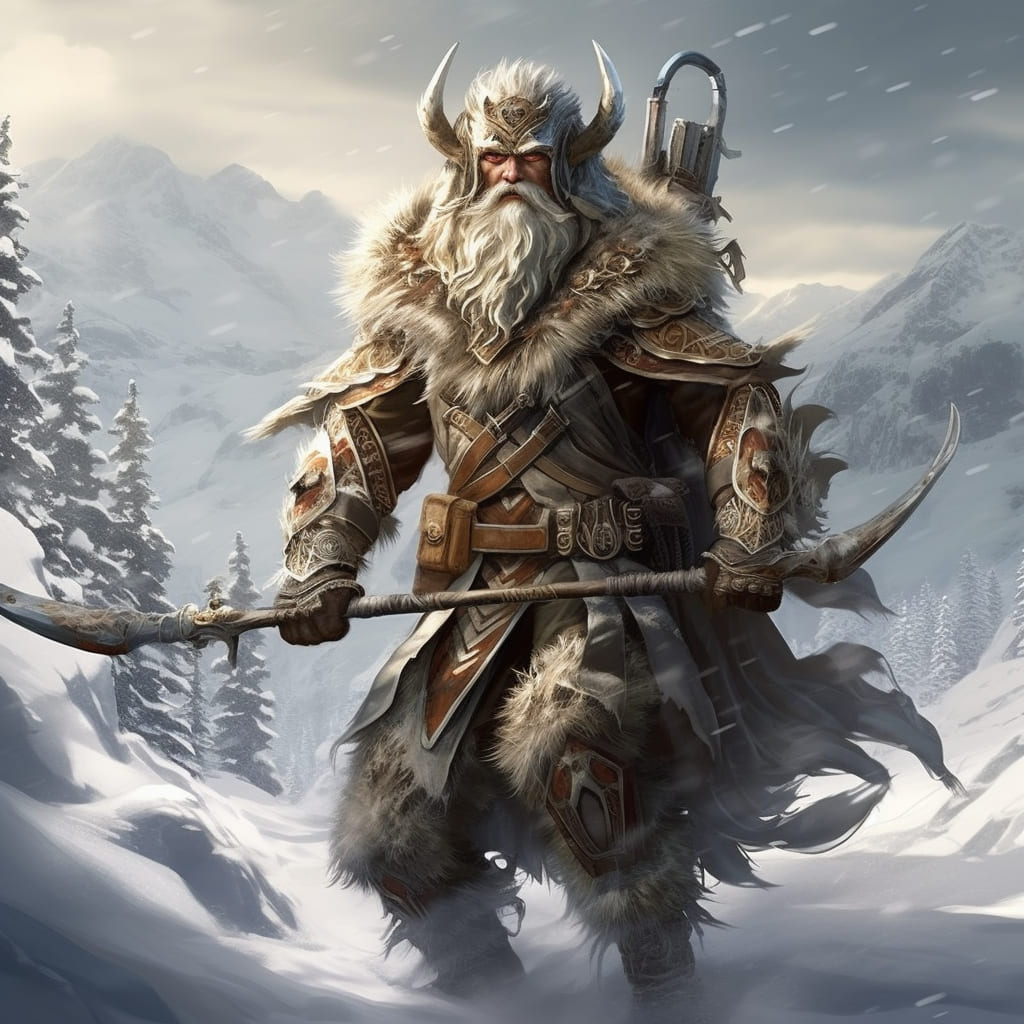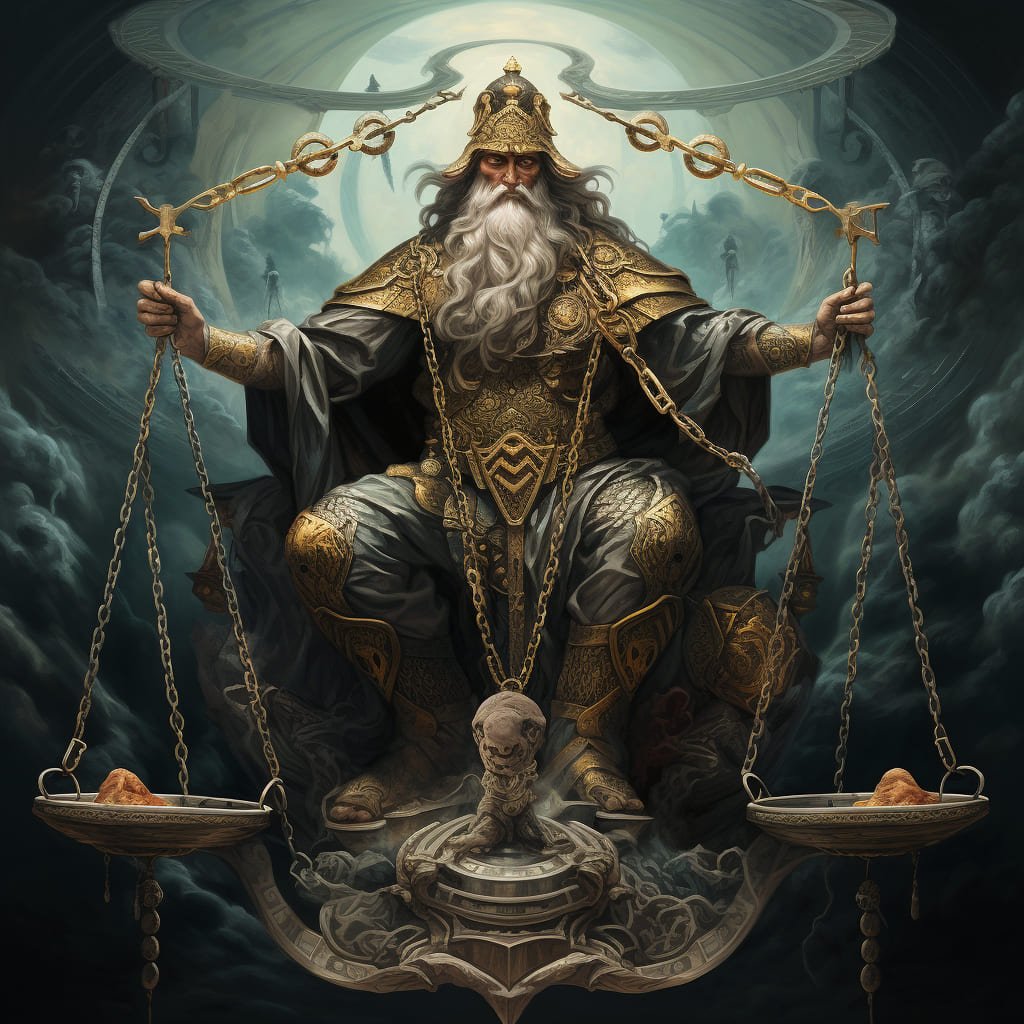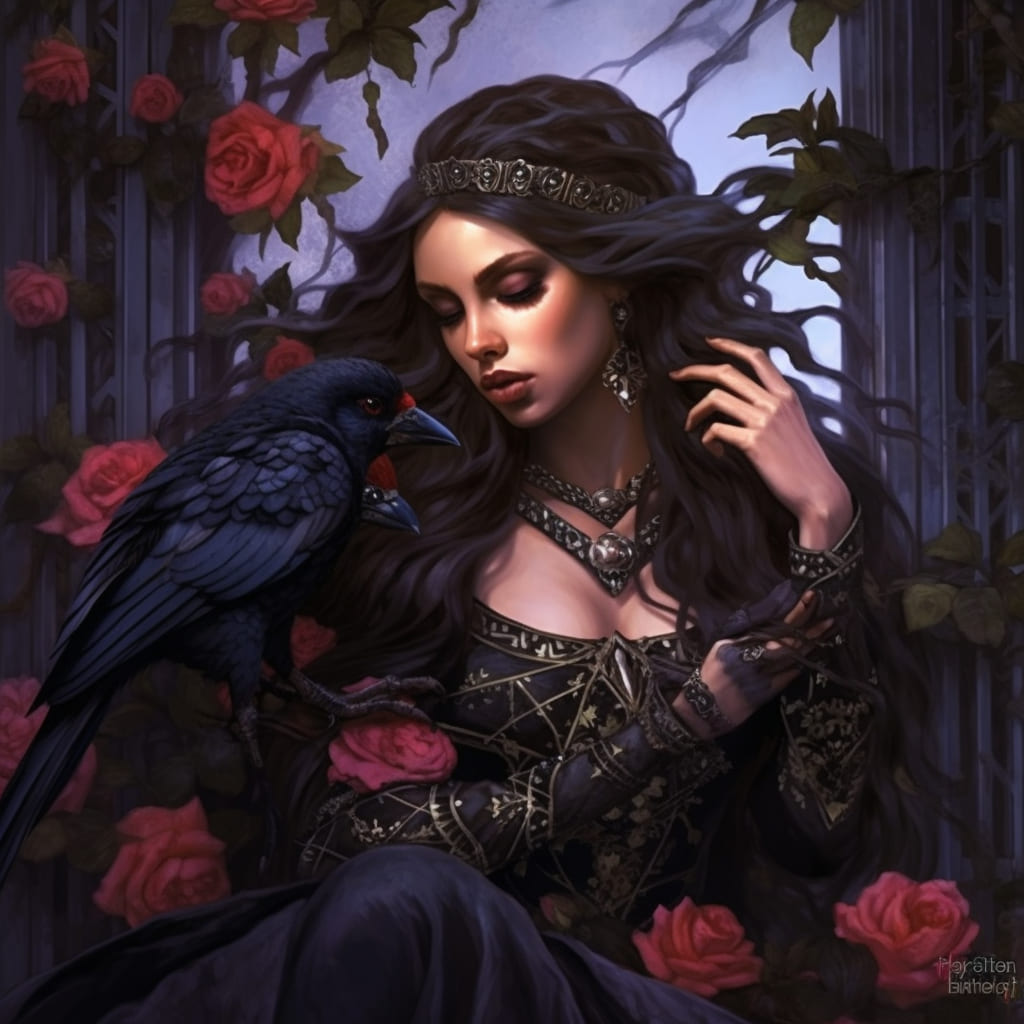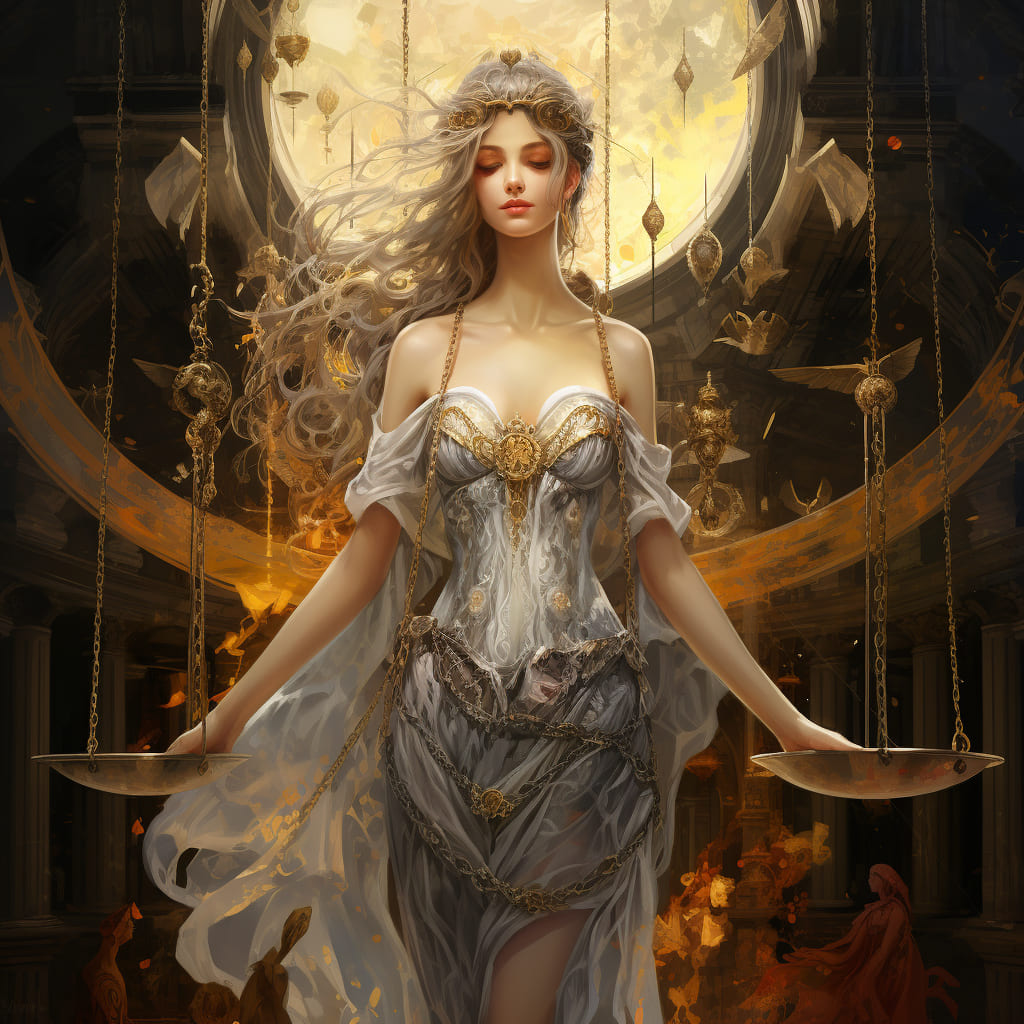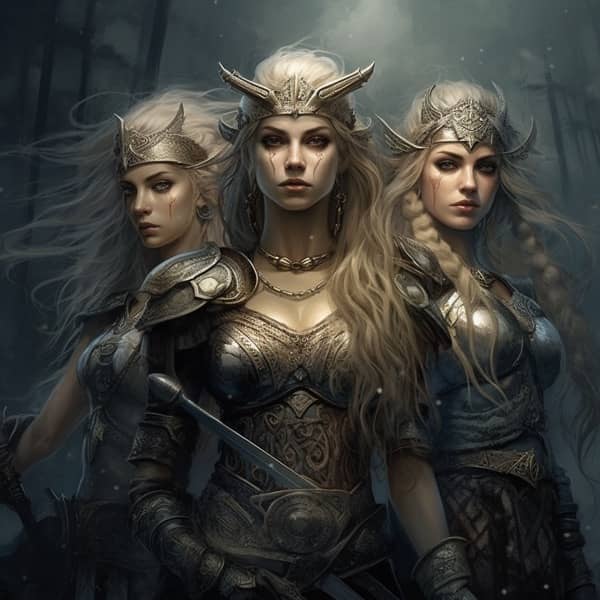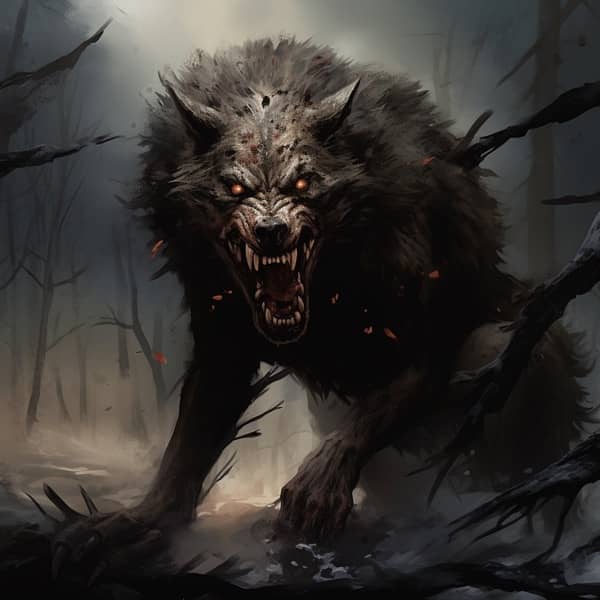Explore the Enthralling World of Norse Mythology
In the misty past of the ancient north, long before the dawn of recorded history, a complex and captivating world of gods and goddesses, mythical creatures, epic sagas, and cosmic realms evolved, steeped in valor, wisdom, cunning, and the primal struggle of chaos against order. This world, which once shaped the lives and beliefs of the Nordic people, is known as Norse mythology.
Norse mythology encompasses the religious traditions of the Norsemen, seafaring warriors and traders from Scandinavia – modern-day Norway, Sweden, Denmark, Iceland, and the Faroe Islands. This mythology was not simply a religion in the way we understand it today; it was interwoven with the fabric of daily life and the natural world. The tales and characters embodied their understanding of life, death, nature, the universe, and human nature, and provided moral and practical guidance.
The deities of Norse mythology are a diverse assembly, each representing different aspects of life, nature, and human characteristics. They can be brave, cunning, treacherous, wise, loving, destructive, or nurturing. The gods are not immortal in the Judeo-Christian sense; they can be hurt and can die. This vulnerability made them relatable and perhaps more human to the Norse people.
The most familiar and central to the Norse pantheon are the gods and goddesses of the Aesir and the Vanir. The Aesir gods dwell in Asgard, high above the mortal world. They are gods of human society, associated with skills, war, wisdom, and the spiritual realm. The Vanir gods, in contrast, are tied to the natural world, fertility, prosperity, and the physical and sensual aspects of life.
Embark on a journey through this fascinating mythological landscape to meet the Gods and Goddesses of the Aesir and the Vanir, explore their tales and understand their significance in the grand tapestry of Norse mythology.
Norse Gods and Goddesses in Norse Mythology
Norse mythology is rich with a pantheon of deities, divided into two main groups: the Aesir and the Vanir. The Aesir gods are primarily associated with order, power, and war, while the Vanir are linked with fertility, wealth, and wisdom. Despite initial tensions leading to a war, the two groups eventually lived in peace, with deities from both sides becoming integral parts of Norse religious practices and mythology.
Aesir Gods in Norse Mythology
The Aesir gods are the primary pantheon of deities in Norse mythology. These gods are associated with the sky, warfare, and authority, among other things.
Aesir
The Aesir are the primary pantheon of gods in Norse mythology, often contrasted with the Vanir, a secondary group of deities associated with fertility, prosperity, and wealth. The Aesir, however, are mostly linked with power, warfare, and the sky. They reside in Asgard, one of the Nine Worlds, a place separated from the realm of humans (Midgard) by the rainbow bridge, Bifrost.
Odin, also known as the All-Father, is the leader of the Aesir. He is the god of wisdom, war, poetry, and magic. He is often depicted as a one-eyed man with a long beard, carrying a spear named Gungnir. Odin’s thirst for knowledge is legendary. He sacrificed one of his eyes to drink from Mimir’s Well of Wisdom, gaining immense knowledge. He also hanged himself from Yggdrasil, the world tree, to gain the knowledge of runes.
Read More about Aesir
Odin
- God of: The Allfather, Odin is the god of war, wisdom, poetry, magic, and the dead.
- Son of: Odin is the son of Borr and the giantess Bestla.
- Husband/Consort of: Odin is the husband of Frigg, the queen of the Aesir.
- Father of: Odin fathered many children. Among his most notable are Thor (with Jord), Baldr, Hodr, and Vidar (with Frigg), and Heimdall (with nine giantesses).
- Other names: Odin is known by many names, including Woden, Wotan, and Wodanaz in Old English, Old Saxon, and Old High German respectively. He has over 200 epithets including Allfather, Ygg (The Terrible), and Baleyg (Flaming Eye).
- Weapon: Odin is often associated with his magical spear, Gungnir. Crafted by dwarves, it is said that Gungnir never misses its target. Odin also has a pair of ravens, Huginn and Muninn (thought and memory), who fly around the world gathering information for him.
Read More about Odin
THOR
- God of: Thunder, Strength, and Weather
- Son of: Odin (father) and Jord (mother), the personification of Earth.
- Husband/Consort of: Sif, a goddess known for her golden hair and associated with earth, fertility, family, and wedlock.
- Father of: Magni, Modi, and Thrud. Magni and Modi are his sons through the giantess Jarnsaxa, and Thrud is his daughter with his wife Sif.
- Other names: Also known by several other names and kennings including Donar (in Old High German), Thunor (in Old English), Þórr (in Old Norse), and Thunderer.
- Weapon: Mjölnir, a hammer that is one of the most fearsome and powerful weapons in existence, capable of leveling mountains and always returning to Thor after it has been thrown.
Read More about Thor
Týr
- God of: War, Justice, and Law
- Son of: There are different interpretations from various sources. Some texts suggest he is the son of Odin, while others hint at him being the son of the giant Hymir.
- Husband/Consort of: It is not clearly stated in the surviving texts if Týr had a wife or consort.
- Father of: There are no well-known myths that directly attribute any children to Týr.
- Other names: Known as Tiw in Old English and Ziu in Old High German. Týr is associated with “Tiwaz”, a rune in the Elder Futhark runic alphabet.
- Weapon: There is no specific weapon associated with Týr. However, he is known for his brave sacrifice of his right hand to the monstrous wolf, Fenrir, during the beast’s binding.
Read More about Týr
Heimdall
- God of: Light, Foresight, and Vigilance
- Son of: According to the Eddas, Heimdall is known as the “Son of Nine Mothers,” who are believed to be nine giantesses, although their names are not explicitly mentioned.
- Husband/Consort of: Unlike many Norse gods, Heimdall is not noted for having a wife or consort in the surviving texts.
- Father of: In some interpretations, Heimdall is considered the forefather of humankind. In the Rigsthula, he fathers three social classes, founding the hierarchical structure of Norse society.
- Other names: Heimdall is also known as Rig, Hallinskiði, and Gullintanni.
- Weapon: Heimdall possesses the Gjallarhorn, a mythical horn that he will blow to signal the onset of Ragnarok, the end of the world.
Read More about Heimdall
Baldr
- God of: Light, Beauty, Innocence, and Purity
- Son of: Odin and Frigg
- Husband/Consort of: Nanna
- Father of: Forseti
- Other Names: The Bleeding God, God of Light, The Shining One
- Weapon: None specifically. Baldr is not primarily known as a warrior god in Norse mythology, and there are no notable weapons associated with him in the lore. His primary symbol is often the sun or a bright light.
Read More about Baldr
Bragi
- God of: God of Poetry and Music
- Son of: According to some sources, he is the son of Odin and the giantess Gunnlod.
- Husband/Consort of: Idunn, the goddess of youth who keeps the apples of immortality.
- Father of: No known offspring.
- Other Names: Bragi Boddason or Bragi the Old (in reference to his wisdom and eloquence). His name is thought to be derived from the Old Norse “bragr,” meaning ‘the best, foremost,’ or ‘poetry.’
- Weapon: No specific weapon is associated with Bragi, as he is primarily known for his eloquence and wisdom, not for warfare. However, as a skald (poet), his words and poems could be seen as his metaphorical weapons.
Read More about Bragi
Höðr
- Name: Höðr (also known as Hod, Hoder, Hodur)
- God of: Associated with winter and darkness
- Son of: Odin and Frigg
- Husband/Consort of: N/A
- Father of: N/A
- Other names: Hoder, Hodur, Hod
- Weapon: A dart or a spear, which he used to unwittingly kill his brother Baldr, guided by the trickster god Loki.
Read More about Höðr
Víðarr
- Name: Víðarr
- God of: Vengeance, Silence, and the Forest
- Son of: Odin (father) and the giantess Gríðr (mother)
- Husband/Consort of: Not specified in the sources
- Father of: No known children
- Other Names: The Silent God
- Weapon: None specifically associated, but he’s known for his thick shoe, which he uses to step on the lower jaw of Fenrir in Ragnarok, while he uses his hands to rip apart the wolf’s mouth, avenging his father Odin’s death.
Read More about Víðarr
Váli
- God of: Vengeance, Rebirth
- Son of: Odin and Rindr
- Husband/Consort of: Not known
- Father of: Not known
- Other Names: Ali, Litle
- Weapon: Not specified
Read More about Váli
Ullr
- God of: Winter, Hunting, Archery, Skiing, and Duelling
- Son of: Sif, and stepson of Thor
- Husband/Consort of: Not specifically mentioned in surviving texts
- Father of: Unknown, no known children are mentioned in surviving texts
- Other Names: Ull, Uller, Ullinn
- Weapon: His bow and his skis, which he used both for traveling and in battle. Also known to have a shield.
Read More about Ullr
Hermod
- God of: Divine Messenger of the Gods
- Son of: Odin
- Husband/Consort of: Not mentioned in surviving sources
- Father of: Not mentioned in surviving sources
- Other names: Hermóðr the Brave
- Weapon: None specifically associated
Read More about Hermod
Forseti
- God of: Justice, Peace, and Truth
- Son of: Baldr and Nanna
- Husband/Consort of: Not applicable, no consort is mentioned in surviving Norse texts
- Father of: Not applicable, no children are mentioned in surviving Norse texts
- Other Names: Fosite (in Old Frisian mythology)
- Weapon: While there is no specific weapon associated with Forseti, he is often depicted with a balanced scale or a book of law, symbolizing his role as a divine judge.
Read More about Forseti
Máni
- God of: Moon
- Son of: Mundilfari
- Husband/Consort of: Not specified in the known Norse texts.
- Father of: Not specified. According to a 13th-century Icelandic poem, Máni takes two children, Bil and Hjuki, from earth, but it is not clear if he is their father.
- Other names: The personified Moon in Norse mythology doesn’t have any other known names apart from Máni, which translates to “Moon”.
- Weapon: Norse mythology does not attribute a specific weapon to Máni. As the personification of the moon, his key “tool” would be the moon itself.
Read More about Máni
Hœnir
- God of: Associated with creation, he’s often depicted as a long-legged, indecisive deity. In some interpretations, he is considered a god of silence or poetry.
- Son of: The parentage of Hœnir is unclear in the Norse sagas. He is often listed among the Aesir but without specific parents mentioned.
- Husband/Consort of: Not applicable, as Hœnir is not depicted with a consort in the Norse sagas.
- Father of: The sagas do not list any offspring of Hœnir.
- Other names: Sometimes called Vili.
- Weapon: Norse texts do not associate Hœnir with a specific weapon.
Read More about Hœnir
Aesir Goddesses in Norse mythology
In Norse mythology, the Aesir are a prominent group of deities who reign over the realm of Asgard and are closely linked with power, war, and governance. Among this pantheon are the Aesir goddesses, powerful and revered figures who play integral roles in the mythological narratives. Unlike the Vanir, their earth-bound counterparts, the Aesir are often associated with the sky, warfare, and aspects of sovereignty. Notable among the Aesir goddesses are Frigg, the queen of the Aesir and wife of Odin, known for her wisdom and foresight; Sif, with her golden hair, the wife of Thor; and Idun, the keeper of the apples of youth. These goddesses, alongside their male counterparts, feature prominently in the ancient Norse sagas, eddas, and skaldic poems, symbolizing the diverse attributes of leadership, beauty, and strength. Their tales and influence permeate the rich tapestry of Norse cosmology, showcasing their importance in the universe’s balance and order.
Frigg
- Goddess of: Love, marriage, fertility, and motherhood.
- Power: As a powerful seeress, she has the ability to know the future but never reveals it. She’s also known for her wisdom and power in magic.
- Appearance: While specific physical descriptions are limited in the myths, Frigg is typically depicted as a beautiful woman wearing a long dress, often blue or white, and sometimes wearing a crown or a cloak adorned with bird feathers.
- Queen Role: Frigg is the Queen of the Aesir gods. She is highly respected and has her own realm in Asgard called Fensalir, which means “Marsh Halls.”
- Wife of: Odin, the chief of the Aesir gods.
- Mother of: Baldr, the beloved god of light and purity; Hǫðr, a blind god who was tricked into killing Baldr; and, in some accounts, Thor.
- Other Names: Frigga, Frea, or Frija in Old High German; and Frīg in Old English. It’s also theorized that she was known as “Earth” in prehistoric Nordic religion.
Read More about Frigg
Sif
- Goddess of: Earth, Family, and Fertility
- Power: As a goddess associated with earth and fertility, Sif was believed to have influence over crops and harvests. She represented the nurturing aspects of the earth.
- Appearance: Sif is renowned for her golden hair, which is often associated with fields of golden wheat, further emphasizing her connection with the earth and harvest.
- Queen Role: While Sif is not traditionally regarded as a queen within the pantheon, she holds a high status as Thor’s wife and the mother of his children.
- Wife of: Thor, the god of thunder, strength, and weather.
- Mother of: Sif is traditionally considered to be the mother of the goddess Thrud by Thor. She is also considered the mother of Ullr in some sources, though the father’s identity varies.
- Other Names: Sif’s name means “relation by marriage,” pointing to her significant role as Thor’s wife. In Old Norse sources, she is only known as Sif.
Read More about Sif
Vanir Gods in Norse Mythology
In the realm of Norse mythology, the Vanir gods stand as an essential and revered group of deities associated with the forces of nature, fertility, and prosperity. While the Aesir gods primarily embody the principles of order, justice, and warfare, the Vanir gods symbolize the cyclical nature of life, the abundance of the earth, and the interconnectedness of all living beings.
Hailing from Vanaheim, their own distinct realm, the Vanir gods bring an air of vibrant vitality and natural energy to the Norse pantheon. They possess powers and dominion over the earth, its bounties, and the harmonious balance of its cycles. These gods and goddesses, with their unique attributes and captivating stories, offer a deeper understanding of the intricate workings of the natural world.
Vanir
The Vanir, a prominent group of deities in Norse mythology, symbolize the facets of life connected with fertility, prosperity, and wealth. This group of gods is often contrasted with the Aesir, another pantheon that primarily includes warrior gods like Odin and Thor. The Vanir are frequently associated with more peaceful aspects of existence, embodying the cyclical nature of life, growth, and abundance.
The Vanir pantheon includes some of the most adored and revered figures in Norse mythology. Njord, the sea god associated with wealth, is the most notable of these deities. As a god connected to seafaring and fishing, he was seen as a provider of wealth and prosperity, ensuring bountiful catches for seafarers and fishers. He also was associated with wind and fertile land, further emphasizing his connection to prosperity.
Read More about Vanir
Vanir Goddesses in Norse mythology
In Norse mythology, the Vanir are a group of deities associated with fertility, prosperity, and nature. Among these deities are the Vanir goddesses, who play a significant role in the Norse pantheon. Unlike the Aesir, who are associated with war and sky, the Vanir are more earth-bound and are linked to the realms of prosperity, pleasure, and fertility. Prominent among the Vanir goddesses are Njord, the god of the sea and fishing, and his twin children, Freyr and Freyja, who are respectively the god of peace and fertility and the goddess of love and fertility. Their significance is evident in the ancient Norse sagas and poems, where they are often invoked for blessings of fertility, peace, and prosperity. The interaction between the Aesir and the Vanir, which includes the exchange of deities like Njord, Freyr, and Freyja, highlights the importance of the Vanir goddesses in the broader Norse cosmology.
Hnoss
- Goddess of: Not specifically detailed, but she’s often associated with beauty or treasures because her name is said to mean “treasure” or “jewel.”
- Power: Her main attribute is her unparalleled beauty.
- Appearance: Not detailed in ancient sources, but given her association with beauty, she is imagined to be incredibly beautiful.
- Queen Role: Not applicable or not detailed in sources.
- Wife of: Not applicable, as she is usually described as a child.
- Mother of: Not mentioned.
- Other names: None known.
Gersemi
Read More about Hnoss and Gersemi
Mythical Beings and Creatures in Norse Mythology
Norse mythology, an integral part of Scandinavian heritage, serves as a treasure trove of fascinating entities and creatures. These creatures have captivated audiences for centuries, shedding light on the belief systems, rituals, and cultural values of ancient Scandinavian societies. The mythology showcases an array of supernatural beings, from benevolent spirits to monstrous beasts.
Unveiling the Mighty Gods and Goddesses
As we step into the realm of Norse mythology, we’re greeted by a pantheon of powerful deities that mirror the natural forces around us. Picture this: Odin, the Allfather, with his one eye and his insatiable quest for wisdom, akin to a wise old wanderer who’s roamed the world’s nooks and crannies. And then there’s Thor, the hammer-wielding thunder god, a true force of nature, whose mighty strikes resonate like thunderbolts in the heart of a storm.
A World Alive with Enigmatic Creatures
But the Norse cosmos isn’t just the playground of gods – it’s also home to a menagerie of creatures that blur the lines between reality and imagination. Have you ever heard of the mischievous and clever Loki, a shape-shifting trickster who’s both a friend and a foe, much like the ever-changing currents of a river? Or the valiant Valkyries, fierce warrior women soaring through the skies like eagles, choosing the bravest souls to join them in the halls of Valhalla, reminiscent of a valiant commander leading their troops into battle?
Diving into the Mystical Realms
Now, imagine walking through the dense woods and stumbling upon Alfheim, the realm of the light elves. It’s like stepping into a sunlit glade where magic dances on every leaf, and time seems to slow down. And don’t forget about Svartalfheim, the land of the dark elves, where master craftsmen create wonders beyond human imagination. It’s as if you’re in an ancient forge, surrounded by the rhythmic pounding of hammers on anvils, crafting dreams into reality.
The Dance of Fire and Ice
Norse mythology is a dance of contrasts, much like the eternal tug-of-war between fire and ice. The ice giants of Jotunheim stand tall and powerful, akin to ancient mountains that have withstood the test of time. On the flip side, the fire giants of Muspelheim embody the scorching heat of volcanoes, ready to reshape the very landscape they inhabit. It’s a symphony of destruction and creation, where the clash of elements mirrors the ebb and flow of life itself.
Guardians of the Underworld
Ah, the enigmatic guardians of the underworld – Hel and the fearsome dragon Nidhogg. Hel, with half her face radiant as the sun and the other half as dark as the night, is like a mirror reflecting the dual nature of our own existence. And Nidhogg, coiled around the roots of the World Tree, gnawing at the very foundation of the cosmos, symbolizes the inexorable passage of time. It’s as if they guard the secrets of life and death, like ancient sentinels watching over the cycle of existence.
Epic Quests and Heroic Feats
Norse mythology is a saga of epic quests and heroic feats, much like the stories of daring explorers charting unknown waters. Consider the tale of Sigurd, a hero who slew the mighty dragon Fafnir, only to be consumed by the greed for gold – a reminder that even the greatest triumphs can be tainted by our own desires. It’s a reflection of our own struggles, where victories often come hand in hand with sacrifices.
The End and the Beginning
And so, dear wanderers, as we come to the end of our journey through the realms of Norse beings and creatures, we’re reminded that every ending is a new beginning. Just as the world is fated to be reborn after Ragnarok, the apocalyptic battle between gods and giants, our exploration of these ancient myths breathes new life into tales that have endured for centuries.
So, the next time you look up at the stars and feel a gust of wind that seems to carry echoes of a distant era, remember that the
world of Norse mythology is alive and well, woven into the very fabric of our collective imagination. These beings and creatures are more than just stories – they’re mirrors reflecting our own nature, our struggles, and our aspirations. And just like the eternal flame burning in the heart of Muspelheim, their legacy continues to burn brightly in the hearths of those who seek to unravel their mysteries.
The Supernatural Pantheon in Norse Mythology
The Supernatural Pantheon in Norse mythology represents an intricate system of gods and goddesses each having their own realm, characteristics, and followers. The gods of Norse Pantheon are usually categorized into two main families: the Aesir and the Vanir.
The Aesir were considered the primary gods, including entities like Odin, the chief god associated with wisdom, poetry, death, and magic; Thor, the god of thunder and protector of mankind; Loki, the trickster god known for his mischiefs; and Frigg, Odin’s wife, the goddess of love and destiny. The Aesir gods resided in Asgard, one of the Nine Worlds.
The Vanir, on the other hand, were associated with fertility, prosperity, and wealth. They were worshipped for bountiful harvests and peace. Freyr and
Freya were among the prominent Vanir gods. They initially resided in Vanaheim before joining the Aesir as part of a truce following the Aesir-Vanir War.
Not to forget, there were other divine entities outside of the Aesir and Vanir. These include the Norns, female beings who controlled destiny; Valkyries, who chose the bravest of the slain warriors to serve Odin in Valhalla; and Einherjar, the heroic
dead residing in Valhalla who would fight during Ragnarok.
Norse mythology presents a pantheon as diverse as life itself, encompassing all aspects of existence from creation to destruction, love to conflict, and wisdom to folly. Its tales, characters, and values have permeated throughout the ages, influencing literature, arts, and popular culture to this day.
Thor, Odin’s son, is one of the most revered Aesir gods. Known as the god of thunder, he wields the mighty hammer Mjölnir. Thor is associated with strength, storms, and fertility, protecting both the gods and humans from the giants. He is often depicted as a robust and hearty god, quick to anger but also just and fair.
Frigg, Odin’s wife, is the queen of the Aesir. As the goddess of marriage, motherhood, and love, she is deeply loved and respected. She is also associated with prophecy and fate, though she never reveals her visions.
Loki, a complex figure in Norse mythology, is also part of the Aesir, although his parentage traces back to the giants. Loki is a shapeshifter, known for his cunning and deceitful nature. He is often the cause of conflict among the gods, but also helps them resolve difficult situations with his clever solutions. Despite his troublesome nature, he is an inseparable part of the Aesir.
Other gods among the Aesir include Baldur, the god of light and beauty; Tyr, the god of law and heroic glory; Heimdall, the watchman of the gods; and Bragi, the god of poetry and eloquence.
Together, the Aesir represent the various aspects of life and existence as understood by the Vikings. The tales of their heroism, wisdom, deceit, and power form the crux of Norse mythology, shaping the beliefs and values of the Nordic culture.
Creatures of Norse Mythology and Modern Influence
The reach of Norse mythology extends far beyond the realm of ancient history, and its creatures continue to influence modern culture.
Literature and Film
Norse mythology has deeply inspired modern literature, particularly the fantasy genre. J.R.R. Tolkien’s Middle-Earth saga is a notable example. In recent years, Norse myths and their creatures have also been adapted into popular film and television series, like the Marvel Cinematic Universe’s portrayal of Thor and Loki.
Video Games
Many popular video games draw heavily from Norse mythology. Franchises like “God of War” and “Assassin’s Creed Valhalla” have captivated gamers with their reimagining of the Norse cosmos and its creatures.
Symbolism and Metaphors
Norse Myths & Legends
Myths and legends often serve as the foundational tales that shape a culture’s beliefs, values, and understanding of the world. Norse mythology, which originates from ancient Scandinavian folklore, is no exception. These stories, rich in drama and moral lessons, feature gods, giants, and other mystical creatures facing challenges, betrayals, and epic battles.
- Creation Myth: This story explains the origin of the world and the first beings. It showcases the power of nature, emphasizing the transformative power of fire and ice. The emergence of the cosmic cow and the giant symbolize life coming from the most unexpected sources.
- The Building of Asgard’s Wall: This legend showcases the cunning of the gods, especially Loki, and their desire to protect their realm at any cost. It also highlights the recurring theme of giants wanting to marry goddesses, especially Freya.
- The Theft of Thor’s Hammer: This story is a testament to Thor’s strength and the cunning of Loki. The theme of disguise is common in many mythologies, where characters change their form to achieve their goals.
- Odin’s Quest for Wisdom: Odin’s sacrifices for knowledge speak to the idea that wisdom often comes at a high price. By sacrificing an eye and undergoing immense physical pain, Odin earns deep knowledge, suggesting that true wisdom isn’t just handed over but requires sacrifice.
- The Binding of Fenrir: This legend warns of the dangers of unchecked power and the lengths the gods will go to prevent a prophecy. It also touches on betrayal and the personal sacrifices made by the gods, like Týr losing his hand.
- Loki’s Punishment: Loki, the trickster god, is a central figure in Norse myths. His punishment serves as a tale of retribution, reminding listeners of the consequences of betrayal and mischief.
- Ragnarok: The concept of an end-times battle is not unique to Norse mythology, but the details in Ragnarok are distinctly Norse. It underscores the cyclical nature of life, death, and rebirth, suggesting that even in destruction, there is the hope of a new beginning.
- The Mead of Poetry: This story elevates the value of wisdom, poetry, and scholarly pursuits. It also showcases Odin’s daring and cunning nature as he goes to great lengths to obtain the precious mead.
These myths, like others from different cultures, offer insights into human nature, our fears, desires, and values. They also provide a rich tapestry of stories that continue to inspire modern-day books, films, and artworks. The characters, both divine and monstrous, and the intricate web of relationships between them highlight the complexities of existence, the struggles of power and knowledge, and the inevitability of change.
Artifacts & Symbols in Norse mythology
Norse mythology is replete with a range of artifacts, symbols, and objects of power that held significant meaning and played pivotal roles in various legends and stories. These artifacts often symbolized the might of the gods, the interconnectedness of the universe, or the overarching themes of fate, bravery, and transformation. Here’s a look at some of the most iconic artifacts and symbols:
Mjölnir:
- Description: Thor’s hammer, Mjölnir, is one of the most recognizable symbols in Norse mythology.
- Significance: It represents Thor’s might as the god of thunder and his role in protecting Asgard from giants. Mjölnir also symbolizes protection and is often worn as an amulet even in modern times.
Read More about Mjölnir
Yggdrasil:
- Description: The World Tree, a cosmic ash tree that connects all of existence.
- Significance: It embodies the interconnectedness of the universe, linking the realms of gods, humans, and the underworld. Creatures like the Nidhogg dragon and the Stag dwell within it, representing various cosmic forces.
Read More about Yggdrasil
Gungnir:
- Description: Odin’s spear, crafted by the dwarves.
- Significance: A symbol of authority and power, it never misses its mark. Odin pierced himself with Gungnir during his sacrifice for wisdom.
Read More about Gungnir
Draupnir:
- Description: A magical gold ring that produces more gold.
- Significance: Belonging to Odin, it represents wealth, abundance, and the cyclical nature of creation. It drips eight more rings every nine nights, symbolizing regeneration.
Read More about Draupnir
Valknut:
- Description: A symbol consisting of three interlocked triangles.
- Significance: Often associated with Odin, it symbolizes death, rebirth, and the afterlife. The precise meaning remains debated, but it is often seen on runestones and burial sites.
Read More about Valknut
Horns of Odin:
- Description: A symbol made up of three interlocking drinking horns.
- Significance: This symbol might be connected to the Mead of Poetry that Odin consumed, representing poetic inspiration and transformation.
Read More about Horns of Odin
Gleipnir:
- Description: The magical ribbon that bound Fenrir.
- Significance: Although it was as thin as a silk ribbon, it was stronger than any chain, symbolizing that appearances can be deceiving and that true strength might come from unexpected sources.
Read More about Gleipnir
Fehu Rune:
- Description: A rune that looks like an upward-pointing arrow.
- Significance: Represents cattle or wealth, indicating prosperity and abundance.
Read More about Fehu Rune
Jormungandr:
- Description: The Midgard Serpent, a giant sea serpent that encircles the Earth.
- Significance: Represents the cyclical nature of life and death, as it bites its own tail. Its release from the sea is said to be one of the omens of Ragnarok.
Read More about Jormungandr
Brísingamen:
- Description: A beautiful necklace worn by Freya.
- Significance: Represents beauty, desire, and fertility. Freya’s acquisition of the necklace involves tales of seduction and deceit.
Read More about Brísingamen
Each of these artifacts and symbols carries deep meaning, and when examined in the context of their myths, they offer a glimpse into the values, beliefs, and cosmological views of the Norse people. Whether as tools of the gods or symbols on a stone, they continue to captivate our imagination and connect us with a rich tapestry of ancient lore.
Latest News
Lorem ipsum dolor sit amet, consectetuer adipiscing elit, sed diam nonummy nibh euismod .
Our blog
Norway has a deep history. From the late 8th to the early 11th century, it [...]
The Vikings are well known for their exploits in the sea and on land. Still, [...]
Scandinavia’s landscape is filled with the marks of the Vikings. Viking burial sites stretch from [...]
The idea of a Nordic Viking castle is often seen as a myth but based [...]
Viking history in North America goes beyond myths and stories. Archaeological finds prove that Norse [...]
Have you ever considered ancient Viking monuments? They give us a peek into the rich [...]
Viking ring fortresses were key during the Viking Age, and places like Nonnebakken in Odense [...]
Explore the captivating legacy of the Vikings in Iceland. Their ancient footprints are preserved in [...]












